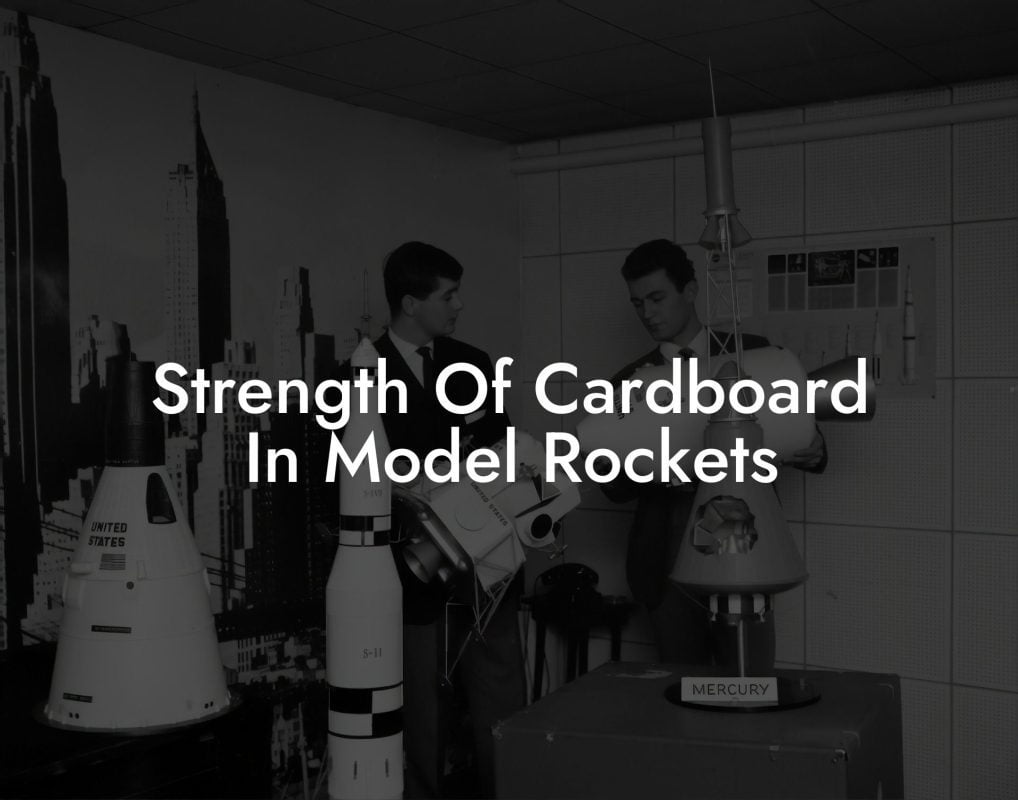Imagine blasting off into the stratosphere, leaving a trail of excitement and wonder in your wake. Welcome to the world of awesome model rockets, where the thrill of launch meets the art of precision engineering. Whether you're a seasoned rocketeer or just starting your intergalactic journey, this comprehensive guide will propel you into the stratosphere of model rocketry.
Quick Links to Useful Sections
What Are Model Rockets?
Model rockets are scaled-down versions of real rockets, designed to simulate the experience of space exploration without the hefty price tag. These miniature marvels come in various shapes, sizes, and levels of complexity, catering to enthusiasts of all ages and skill levels.
From beginner-friendly kits to advanced, custom-built creations, model rockets offer a unique blend of science, technology, engineering, and mathematics (STEM) education, creativity, and pure, unadulterated fun.
The Science Behind Model Rockets
Model rockets operate on the same fundamental principles as their full-scale counterparts. The key to a successful launch lies in understanding the forces of thrust, drag, and gravity.
- Thrust: The upward force generated by the rocket's engines, propelling it into the air.
- Drag: The resistance created by air molecules, slowing the rocket's ascent.
- Gravity: The downward force pulling the rocket back towards the Earth's surface.
By balancing these forces, model rocketeers can achieve remarkable altitudes, precision landings, and even deploy payloads like cameras or sensors.
Looking For The Best Model Rocket Kits? You'll Love These:
Types of Model Rockets
The world of model rockets is incredibly diverse, with various categories catering to different interests and skill levels.
- Beginner Rockets: Pre-assembled, easy-to-launch kits perfect for newcomers to the hobby.
- Mid-Power Rockets: More complex, larger models requiring some assembly and basic construction skills.
- High-Power Rockets: Advanced, high-performance models demanding expertise in design, construction, and safety protocols.
- Scale Models: Accurate replicas of real rockets, often featuring intricate details and realistic paint schemes.
- Competition Rockets: Custom-built models designed for competitive events, emphasizing speed, altitude, and precision.
Building and Customizing Your model rocket
One of the most rewarding aspects of model rocketry is designing and building your own creations. With a little creativity and some basic tools, you can transform a standard kit into a unique, high-performance machine.
- Materials: Explore various materials, such as balsa wood, plastic, or fiberglass, to create lightweight yet durable structures.
- Design Software: Utilize computer-aided design (CAD) programs to visualize and optimize your rocket's shape and performance.
- Painting and Finishing: Add a personal touch with custom paint schemes, decals, and weathering effects.
As you gain experience and confidence, you can experiment with advanced techniques like 3D printing, carbon fiber construction, or even creating your own rocket motors.
Safety First: Essential Precautions for Model Rocketry
While model rockets are generally safe, it's crucial to follow basic safety guidelines to avoid accidents and ensure a fun, enjoyable experience for everyone involved.
- Launch Site Selection: Choose a wide, open area with minimal obstacles and no overhead hazards.
- Weather Conditions: Avoid launching in strong winds, heavy rain, or extreme temperatures.
- Eye Protection: Wear safety glasses or goggles to protect your eyes from debris and rocket motors.
- Launch Angle and Azimuth: Ensure the rocket is launched at a safe angle and direction to prevent accidental collisions or property damage.
Always follow the manufacturer's instructions, and consider joining a local model rocketry club or organization for guidance and support.
Resources and community Support: Your Next Steps
As you embark on your model rocketry journey, you'll find a wealth of resources and a vibrant community eager to help you succeed.
- Online Forums and Groups: Join online platforms like Reddit's r/modelrockets or Facebook groups dedicated to model rocketry.
- Local Clubs and Organizations: Look for nearby model rocketry clubs, meetups, or events to connect with fellow enthusiasts.
- Tutorials and Guides: Explore YouTube channels, blogs, and websites offering step-by-step tutorials, tips, and advice.
- Manufacturers and Suppliers: Visit websites of model rocket manufacturers, suppliers, and retailers for product information, tutorials, and customer support.
By tapping into these resources and connecting with the model rocketry community, you'll stay inspired, learn new techniques, and take your skills to new heights.
Frequently Asked Questions: Model Rocketry Essentials
Here are some frequently asked questions about model rockets, covering essential topics for beginners and experienced enthusiasts alike:
1. What is the difference between model rockets and toy rockets?
Model rockets are designed for precision, performance, and realism, whereas toy rockets are primarily for entertainment and often lack the complexity and accuracy of model rockets.
2. How high can model rockets fly?
Depending on the design and motor, model rockets can reach altitudes ranging from a few hundred feet to several miles.
3. Are model rockets safe?
When used responsibly and following safety guidelines, model rockets are generally safe. However, accidents can occur if proper precautions are not taken.
4. Can I build my own model rocket motor?
Yes, experienced enthusiasts can design and build their own rocket motors, but this requires advanced knowledge of chemistry, physics, and safety protocols.
5. How do I get started with model rocketry?
Begin with a beginner-friendly kit, follow the instructions, and gradually move on to more complex projects as you gain experience and confidence.
Looking For The Best Model Rocket Kits? You'll Love These:
Useful Interruption: Dive deeper into the world of Model Rockets with our most popular sections. If there is anything you think is missing or anything you would love for us to write about, just give us a shout.
- Getting Started & Basics With Model Rockets
- Model Rocket Design, Build & Customization
- Model Rocket Propulsion & Engine Technology
- Model Rocket Launch Techniques & Recovery
- Model Rocket Advanced Rocketry & Innovations
- Model Rocket DIY and Customization
- Model Rocket Equipment Reviews & Digital Tools
- Community, Competitions & Education
- Model Rocket Troubleshooting & FAQs
- Model Rocket Bonus/Seasonal & Niche Topics
A group of model rocket enthusiasts gathered at a field for their weekly launch event. Among them was Dave, a seasoned builder known for pushing the limits of hobby rocketry. This time, he had outdone himself.
“Ladies and gentlemen,” Dave announced, dramatically pulling a cloth off his latest creation, “I present to you: The Kraken!”
The crowd gasped. This wasn’t just a model rocket—it was a monster. The thing stood 8 feet tall, had six clustered engines, and was covered in enough duct tape to qualify as a classified aerospace project.
“Dave,” muttered Steve, the cautious safety officer, “Have you, uh… done the math on this?”
“Math?” Dave scoffed. “I built it in my garage at 3 a.m. with parts from eBay. This is an art piece, Steve.”
The countdown began.
5…
4…
3…
2…
1…
The engines ignited with a BOOM, and The Kraken shot up… kind of. It immediately did a violent barrel roll, narrowly missing the spectators before skyrocketing at an angle that could only be described as “legally questionable.”
The crowd collectively ducked as The Kraken flew straight over the adjacent cornfield, where Old Man Jenkins, the grumpiest farmer in town, was minding his business.
KABOOM!
The rocket disappeared behind the barn. A moment later, a flaming piece of Estes igniter wire landed at Steve’s feet. The silence was deafening.
And then—an unmistakable sound echoed across the field.
Jenkins’ shotgun being cocked.
“DAVE!!!” Steve shouted. “RUN.”
And that was the day Dave invented the first-ever biologically powered rocket booster: pure adrenaline.
To this day, nobody knows where The Kraken landed, but legend has it, it still haunts the skies, terrifying unsuspecting drones and low-flying birds.















